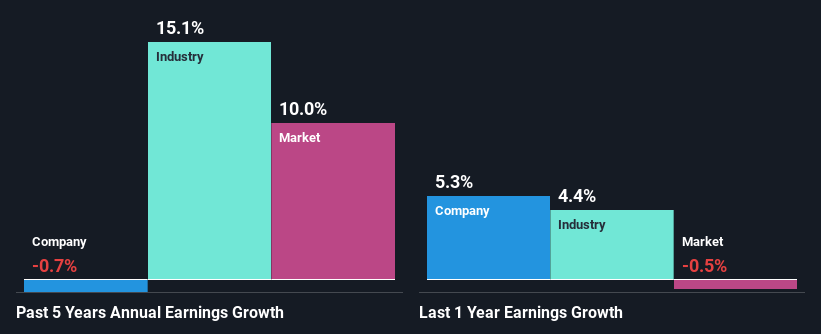Is TalkMed Group Limited's (SGX:5G3) Stock Price Struggling As A Result Of Its Mixed Financials?
It is hard to get excited after looking at TalkMed Group's (SGX:5G3) recent performance, when its stock has declined 2.6% over the past month. It seems that the market might have completely ignored the positive aspects of the company's fundamentals and decided to weigh-in more on the negative aspects. Long-term fundamentals are usually what drive market outcomes, so it's worth paying close attention. Particularly, we will be paying attention to TalkMed Group's ROE today.
Return on equity or ROE is a key measure used to assess how efficiently a company's management is utilizing the company's capital. Put another way, it reveals the company's success at turning shareholder investments into profits.
See our latest analysis for TalkMed Group
How To Calculate Return On Equity?
ROE can be calculated by using the formula:
Return on Equity = Net Profit (from continuing operations) ÷ Shareholders' Equity
So, based on the above formula, the ROE for TalkMed Group is:
35% = S$29m ÷ S$84m (Based on the trailing twelve months to December 2023).
The 'return' refers to a company's earnings over the last year. So, this means that for every SGD1 of its shareholder's investments, the company generates a profit of SGD0.35.
What Is The Relationship Between ROE And Earnings Growth?
Thus far, we have learned that ROE measures how efficiently a company is generating its profits. Based on how much of its profits the company chooses to reinvest or "retain", we are then able to evaluate a company's future ability to generate profits. Assuming all else is equal, companies that have both a higher return on equity and higher profit retention are usually the ones that have a higher growth rate when compared to companies that don't have the same features.
TalkMed Group's Earnings Growth And 35% ROE
Firstly, we acknowledge that TalkMed Group has a significantly high ROE. Additionally, the company's ROE is higher compared to the industry average of 10% which is quite remarkable. Given the circumstances, we can't help but wonder why TalkMed Group saw little to no growth in the past five years. So, there could be some other aspects that could potentially be preventing the company from growing. For example, it could be that the company has a high payout ratio or the business has allocated capital poorly, for instance.
We then compared TalkMed Group's net income growth with the industry and found that the average industry growth rate was 15% in the same 5-year period.
Earnings growth is a huge factor in stock valuation. What investors need to determine next is if the expected earnings growth, or the lack of it, is already built into the share price. Doing so will help them establish if the stock's future looks promising or ominous. One good indicator of expected earnings growth is the P/E ratio which determines the price the market is willing to pay for a stock based on its earnings prospects. So, you may want to check if TalkMed Group is trading on a high P/E or a low P/E, relative to its industry.
Is TalkMed Group Using Its Retained Earnings Effectively?
The high three-year median payout ratio of 101% (meaning, the company retains only -0.8% of profits) for TalkMed Group suggests that the company's earnings growth was miniscule as a result of paying out a majority of its earnings.
Additionally, TalkMed Group has paid dividends over a period of at least ten years, which means that the company's management is determined to pay dividends even if it means little to no earnings growth.
Summary
In total, we're a bit ambivalent about TalkMed Group's performance. In spite of the high ROE, the company has failed to see growth in its earnings due to it paying out most of its profits as dividend, with almost nothing left to invest into its own business. Up till now, we've only made a short study of the company's growth data. So it may be worth checking this free detailed graph of TalkMed Group's past earnings, as well as revenue and cash flows to get a deeper insight into the company's performance.
Have feedback on this article? Concerned about the content? Get in touch with us directly. Alternatively, email editorial-team (at) simplywallst.com.
This article by Simply Wall St is general in nature. We provide commentary based on historical data and analyst forecasts only using an unbiased methodology and our articles are not intended to be financial advice. It does not constitute a recommendation to buy or sell any stock, and does not take account of your objectives, or your financial situation. We aim to bring you long-term focused analysis driven by fundamental data. Note that our analysis may not factor in the latest price-sensitive company announcements or qualitative material. Simply Wall St has no position in any stocks mentioned.

 Yahoo Finance
Yahoo Finance 
